SEC-S19/W2 | Exploring the Genesis Blocks
Hello everyone! I hope you are all doing well and enjoying life with the blessings of Allah Almighty. I am happy to take part in the exciting challenge hosted by SteemitCryptoAcademy community . So, without any further delay, let's dive right in! Shall we ? ........, Okay , Okay😊! .
Explain the importance of the Bitcoin genesis block and describe its contents. |
|---|
The genesis block of Bitcoin is the first block transmitted in the process of forming the Bitcoin blockchain. It is important in that it constituted the activation of the full network with a special message.
This was a block developed by the Bitcoin inventor known as Satoshi Nakamoto on 3rd January 2009 with the heading of a newspaper. According to many, within this headline there is a special message: The exact headline is: “The Times 03/Jan/2009 Chancellor on brink of second bailout for banks. ”
That, written in the block, was the statement: which exposed a finance crisis at that time and introduced Satoshi’s idea of Bitcoin as a peer-to-peer electronic cash system that wouldn’t be regulated by governments and banks.
At a second level, it also contains the rules and regulations of the network as is the case of the Bitcoin network. It is not until the current piece that anything can be referred to as blocks, so in that respect, it is quite original, or even primary.
It is in this block that the birth of Bitcoin, its function and the way it tends to improve financial control, as well as make innovations for the users, are described. That’s a piece which can be considered as history recorded in the blockchain.
The first block has a hidden message: a newspaper headline in the text. The headline in the text is "The Times 03/Jan/2009 Chancellor on brink of second bailout for banks."
 Snap Shot Snap Shot |
|---|
That message references the financial crisis of 2009 and alludes to the concern of Satoshi Nakamoto: who controls money, banks, or governments?.
So, in this message, by including this, Satoshi shepherded Bitcoin's goal: to create a new, decentralized currency. In all this, Bitcoin was intended to put the user in the driver's seat, as opposed to the banker.
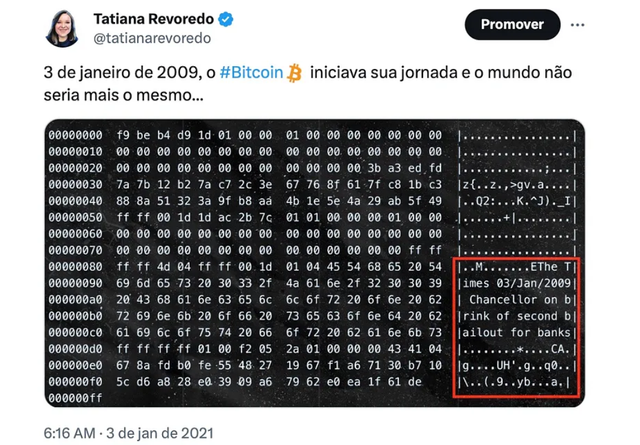 Special secret message : Snap Shot Special secret message : Snap Shot |
|---|
This message really did have quite an impact. It attracted the people who wished for the new financial system. Bitcoin became popular among people annoyed by regular banking.
Primarily, within the genesis block, one is reminded of Bitcoin's original message or philosophy. In this, the birth of a new paradigm in finance is encased.
Compare and contrast Ethereum's genesis block with Bitcoin's. |
|---|
In the elaboration of the genesis blocks between the Bitcoin and Ethereum, an individual will have broadened the knowledge on the origin and the core mandate of the two forms of cryptocurrencies.
Each block tells something about the vision and the technology behind the minds of its builders.
Bitcoin's Genesis Block
The hidden message embedded within it confirmed the latter: "The Times 03/Jan/2009 Chancellor on the brink of second bailout for banks." This showed that the so-considered inspiration for a decentralized currency, in the mind of Satoshi Nakamoto, was a means to keep money out of the control of governments and banks. It said that Bitcoin was to be about financial freedom and innovation.
Ethereum's Genesis Block
Ethereum's genesis block, created in 2015 by Vitalik Buterin, contained no hidden message but implemented smart contracts and decentralized applications. Where Ethereum was envisioned to have much more than just digital money to it, it gave a platform for building decentralized apps, a feature set that made it flexible and programmable as compared to Bitcoin.
Comparison and Contrast
Both the genesis blocks mark the commencement of their respective blockchains, although with a different focus: the Bitcoin genesis block leaned toward financial decentralization and independence from traditional banks, as opposed to the Ethereum genesis block, which leaned more towards technological innovation and the enormous potential lying with decentralized applications.
Whereas the block of Bitcoin is more sending a message about their financial crisis—the block of Ethereum is technical, more specifically, smart contracts. This difference mirrors the varied visions of their creators'—Bitcoin as a new form of money and Ethereum as a platform for decentralized technology.
The Ethereum genesis block features a bit of a difference compared to the Bitcoin genesis block because of the existence of pre-funded accounts and the introduction of smart contracts.
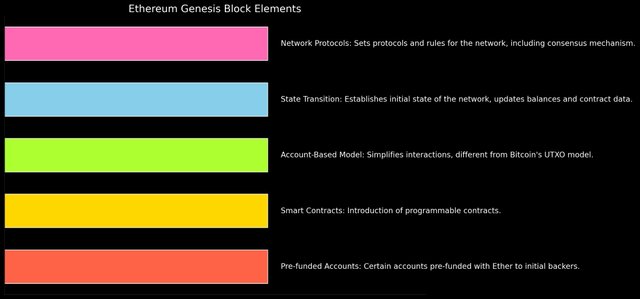 |
|---|
Pre-funded Accounts
In the genesis block of Ethereum, several accounts were pre-funded with Ether. The original backers of the Ethereum project, participating in the crowdsale, owned these accounts. While this type of pre-funding undoubtedly helped to get the wheels of the Ethereum ecosystem in motion, it is also anathema in other respects.
Smart Contracts
Smart contracts were first introduced in Ethereum's genesis block. While the Bitcoin network focuses on transferring value, Ethereum facilitates programmable contracts. A smart contract is a self-executing contract where the agreement terms between two parties are directly written as code lines. They execute actions automatically when pre-defined conditions are met, paving the way for innumerable applications based on decentralized models.
Account-Based Model
Ethereum is based on a model that is account-based, quite different from Bitcoin's UTXO model. That is, each account has a balance and can send transactional requests to other accounts directly. This sets a model to have simpler and more flexible interactions with smart contracts by developers in the network.
State Transition
The genesis block also defines initial state. That is, account balances, and smart contract code. And any time a transaction is executed, the state is updated to the new balance as well as the contract data.
Network Protocols
The Ethereum genesis block allows setting up the network's protocols and rules. This includes a consensus mechanism—initially Proof of Work and later on, a transition to Proof of Stake. Such protocols govern how transactions are validated and added to the blockchain.
These are things that make the Ethereum genesis block foundational for it to be a platform of decentralized applications and offer flexible programmability.
Use a blockchain explorer to find details about Steem's genesis block. What are the main components and transactions in this block? Provide screenshots and links to the browser used. |
|---|
To show block explore i choose an Steemworld.org tool. Start by heading to the SteemWorld.org dashboard and then on the available options at the home page, select "Block Explorer."
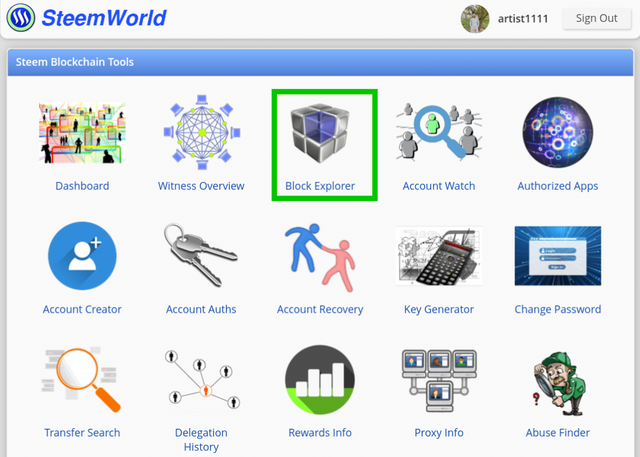 |
|---|
This is indicated among others on the dashboard of the site, depending on the features, with others like Dashboard, Witness Overview, Account Watch, and Authorized Apps.
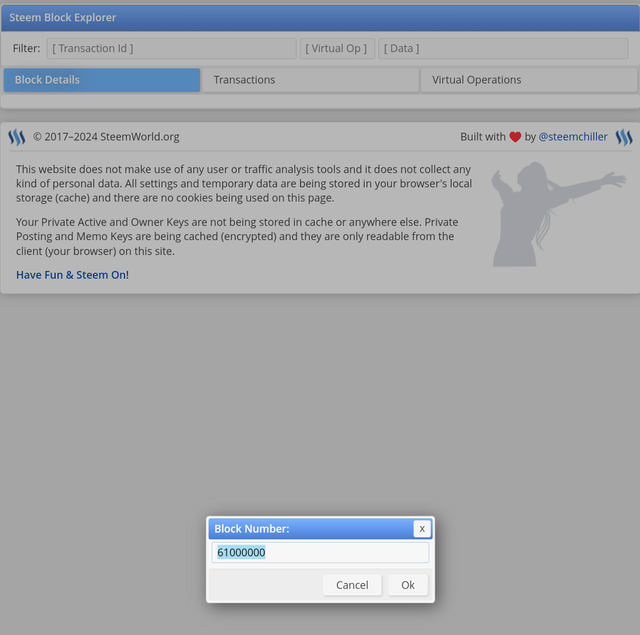 |
|---|
Next, type in the block number. It will automatically be 61000000. You will come across a dialog box that requires you to verify the block number you input. This shall be achieved by simply clicking "Ok." At this point, you are sure you are querying the right block to get more information on it.
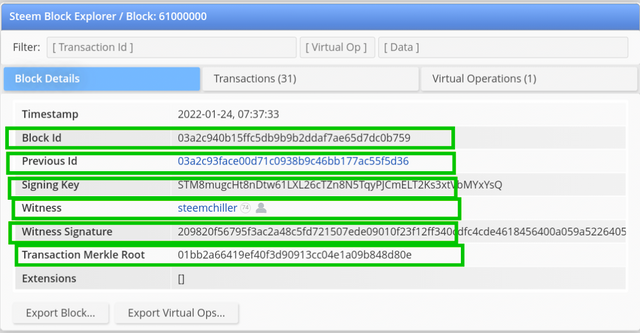 |
|---|
Then it identifies the input block number that says whether this block number is valid and outputs the details of that block. The significant outputs include the timestamp of the block creation, the ID of this particular block, and the previous block ID.
Then the details would reveal the signing key of the block witness, the account name of the witness, witness signature, transaction Merkle root and any extension.
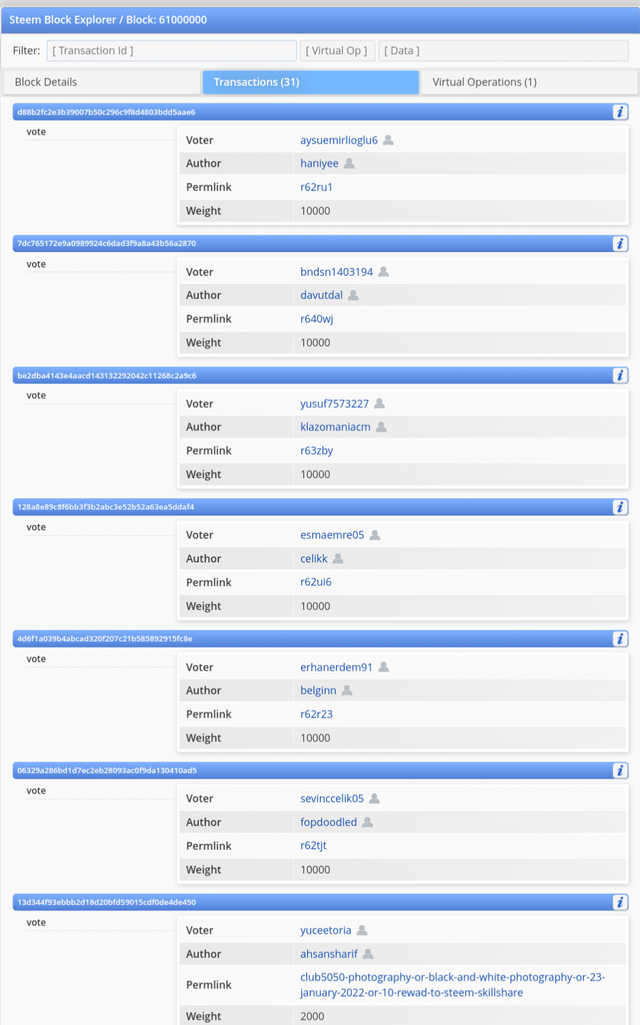 |
|---|
The latter tab, transactions, expands in detail on all of the transactions contained in the block. Voting transactions can contain a high level of detail, which can include the user account who is voting, the author of the content being voted on, the permanent link to the content, and the weight of the vote, among other details.
All these reveal transactions that were captured within that particular block, and the view of these transactions gives a comprehensive outlook on interactions and data stored within.
Compare the genesis blocks of Bitcoin, Ethereum and Steem in terms of goals, underlying technologies and communities.Practical Question: Creating a Genesis Block Guide |
|---|
The genesis blocks of Bitcoin, Ethereum, and Steem hold within them all that explains the goals, technologies, and visions of their respective communities. A comparison of the blocks sheds light on which paths these blockchains have taken.
Bitcoin Genesis Block
- Goals: Decentralized, censorship-resistant money; Satoshi Nakamoto wanted to be an alternative to traditional banking.
- Underlying Technologies: Bitcoin implements Proof of Work as the consensus mechanism. The code ensures secure, immutable transactions.
- Community: The community behind bitcoin values privacy, financial freedom, and independence from centralized institutions. It has often been touted to protect against traditional financial systems.
Ethereum's Genesis Block
- Goals: The aim of Ethereum was to construct a versatile platform for decentralized applications and smart contracts. Vitalik Buterin had proposed working toward a more programmable blockchain.
- Underlying Technologies: Ethereum initially used PoW, but it has shifted to the Proof of Stake algorithm. It introduced the concept of smart contracts and the Ethereum Virtual Machine.
- Community: The community behind Ethereum includes developers, innovators, and business people oriented towards the development of decentralized applications and exploring other possibilities of blockchain technologies besides digital currency.
Steem's Genesis Block
- Purposes: Steem was created to power social media and content platforms. It aimed to incentivize its users for generating and curating content through blockchain technology.
- Core Technologies: Steem uses a Delegated Proof of Stake consensus algorithm. It wants to achieve very fast transactions and high scalability for decentralized social media apps.
- Community: Content creators, curators, and social media enthusiasts make up the Steem community. Principally, it wants to compensate participation and build decentralized social networks.
Comparison
- Goals: Financial decentralization in Bitcoin, flexible application development in Ethereum, and rewarding social media content on Steem.
- Technologies: Bitcoin deploys PoW for security, Ethereum moved to PoS with smart contracts, and Steem deploys DPoS for scalability and speed.
- Communities: The community of Bitcoin values financial freedom; the Ethereum community is very diverse and at the same time very developer-oriented; Steem's community is oriented toward content creation and social media.
Practical Question: Writing a Genesis Block Guide
Create the Genesis Block—Setting the First State of Your Blockchain: A simple guide:
- State the Goals: State clearly what the blockchain is for and what your vision is.
- Choose the Consensus Mechanism: Either PoW, PoS, DPoS, or another.
- Initial Parameters: What was in the initial state, what accounts to pre-fund, what the first rules are, etc.
- Create the Genesis Block: Take the parameters selected above and write it into the genesis block.
- Testing and Launch: The genesis block is tested in a controlled environment before the launch of the main network.
- Building a Community: Share your vision of the blockchain with early adopters and build a community around it.
By understanding the above and following the steps, you will be in a position to build a genesis block to form the fundamental base of your blockchain network.
Write a practical guide explaining how a newcomer can explore and understand the genesis block of a blockchain, using examples from Bitcoin, Ethereum and Steem. |
|---|
A great way to understand a blockchain is to go back to its genesis block—to know where it all began and to realize the vision in the minds of its creators. This guide is aimed at helping newcomers navigate the genesis blocks of Bitcoin, Ethereum, and Steem.
1. Bitcoin Genesis Block
- How to Get to the Genesis Block: Go to blockchain explorers like blockchain.info or blockchair.com. Put in "Block 0" or "Genesis Block."
- Content Understanding: Note the embedded message, "The Times 03/Jan/2009 Chancellor on brink of second bailout for banks," reflecting the vision of Satoshi Nakamoto.
- Technological Insights: Note the hash of the block and its previous block, none for genesis, and that of the transaction. Understand PoW.
- Community Context: Go through online forums and communities like BitcoinTalk to get an idea of how people were discussing and proposing things in the early days.
2. Ethereum Genesis Block
- Getting the Genesis Block: You can get it at etherscan.io or at ethplorer.io. You simply need to search for "Block 0" or the first block.
- Knowing what's inside: Note that there is no message, but there are pre-funded accounts. Prefunded means that these accounts were funded as part of the Ethereum crowdsale.
- Technological Insights: View information about smart contracts and the EVM. Know how PoW was the first pick, and then Proof of Stake.
- Community Context: Just scroll through Ethereum community on Reddit or visit the official Ethereum website to know the vision bigger, or types of innovations.
3. Steem Genesis Block
- Getting the Genesis Block: Open steemdb.com or any Steem blockchain explorer. Search for "Block 0" or the very first block.
- Content Understanding: Observe Delegated Proof of Stake (DPoS) mechanism. Observe initial accounts and transactions created for content creation rewards.
- Technological Views: Understand Steem's concentration on high-speed transactions, scalability in order to support the social media application.
- Community Context: Explore the Steemit platform and Steem forums to understand the community's emphasis on content creation and curation rewards.
Step-by-Step Guide for Newcomers
- Identifying Reliable Resources: Blockchain explorers and official websites of digital assets, along with reputable forums.
- Searching for the Genesis Block: In the search bar of the explorer, type "Block 0" or "Genesis Block."
- Viewing Block Details: The block hash, timestamp, transactions, and any embedded messages can be seen.
- Understanding Technologies: Begin by studying the PoW, PoS, and DPoS consensus mechanisms before moving to specialized features such as smart contracts or content rewards.
- Join forums, read whitepapers, and discuss to gain deeper insights.
- Use the acquired knowledge to analyze other blocks, understand blockchain development, or even create your own blockchain project.
Conclusion
Knowing how a blockchain's genesis block is created can give insight into the goals, technology, and community behind the blockchain. It can help those joining for the first time make broad inferences about the goals, technology, and community by following such steps using examples of Bitcoin, Ethereum, and Steem.
kind Regards
@artist1111
Adieu, folks!
May the winds of fortune
carry you to greatness!
May the winds of fortune
carry you to greatness!
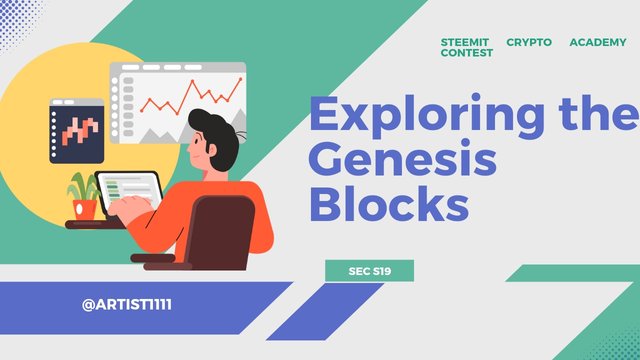

Upvoted. Thank You for sending some of your rewards to @null. It will make Steem stronger.
!upvote 15
💯⚜2️⃣0️⃣2️⃣4️⃣ Participate in the "Seven Network" Community2️⃣0️⃣2️⃣4️⃣ ⚜💯.
This post was manually selected to be voted on by "Seven Network Project". (Manual Curation of Steem Seven).
the post has been upvoted successfully! Remaining bandwidth: 60%
Your post has been rewarded by the Seven Team.
Support partner witnesses
We are the hope!
Great. Your detailed explanation on genesis block is informative.
Thanks! I'm glad you found the explanation on the Genesis block informative.
Greetings
I hope you are great you have shared brief knowledge about the topic, very well explained about bitcoin block Genesis and the hidden message inside it.
Moreover you explained in detail the impact of bitcoin Genesis block abs its message which is very clear to understanding.
You throwing light in BTC and ETH which shows your deep research in the current topic overall you gave a good knowing especially who wanted to learn about the block Genesis.
Good luck
Thanks for your kind words! I'm glad you found the explanation on the Bitcoin Genesis block and its impact insightful.
Hello bro you wrote well, I love how you explained every term in simplest format, please keep it up 💪🏼
Yes friend this refunding activity was used to help distribute ether to different individuals after the ICO which meet a initial coin offering. I love the fact that you explained your word in a simplest format please keep it up.
Thanks for sharing, please engage on my entry through the link below 👇🏼https://steemit.com/hive-108451/@starrchris/eng-esp-steemit-crypto-academy-contest-s19w2-exploring-the-genesis-blocks-or
Thanks for the appreciation! I'm glad you found the explanation clear and helpful. I'll keep it up!
I see that, like me, you also choose SteemWorld as one of your favorite Steem tools. It provides thorough information about Steem blockchain, I guess. Do you happen to know another Steemit tools like this?